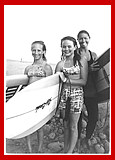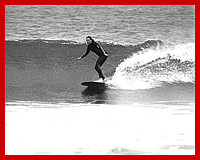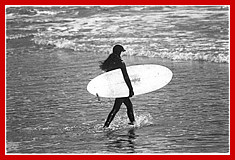
Reframing the Image of Women Surfers
Story
by Nina Wu
Photos by Elizabeth Pepin
"Surfers
are not just men," Pepin said. "I think it’s important
to dispel that myth."
Skim through the pages of a typical surfer magazine and what do you see? Flip. A surfer "dude" flies up the face of a wave on a Hurley International surfboard. Flip. Another surfer "dude" splashes down the face of a wave in an advertisement for Reef surf shoes. To the side, a backside photo of "Traci" in a thong bikini suggests that anyone who buys these shoes will win her admiration.
Until recently, surfing has been portrayed in the media as a male sport. The glossy, colorful pages of magazines feature images of only surfer "dudes" riding the waves and executing fancy maneuvers. During the 80s and earlier, the majority of competitors and photographers covering them were male, with an occasional oddball female among them. Chances were that if a female appeared in any of the magazines, she was a "bikini babe" tanning on the beach rather than a serious surfer.
Yet serious female surfers have been riding the waves all along. They have gained more recognition in the media today, with numerous professional female surfers endorsing the sport's products and touring the Association of Surfing Professionals (ASP) circuit. However, the images of female surfers still leave something to be desired.
KQED associate producer and surfer Elizabeth Pepin is making an effort to change that. After working in London from 1989 to 1991, she returned and discovered that more and more women were riding the waves, but that this wasn’t reflected accurately in the media.
"It really began to bother me the way they showed women," Pepin said. "I don’t have a problem with women in bikinis. But they would never show these women surfing."
And if you’re surfing at Ocean Beach, she added, you probably wouldn’t want to wear a bikini, because you’d freeze in anything less than a wetsuit. A bikini would probably work better in the warmer waters of Southern California or Hawaii.
In an effort to combat the missing and misinformed images, Pepin began traveling up and down the coast of California taking portraits of women surfers, using black and white film to counter the glossy, glamorized shots featured in most magazines. "I just wanted some sort of record," she said. Her inspirations are 1930s and 40s surf photographers like Doc Ball and Leroy Grannis.
So far, Pepin has compiled a portfolio of nearly 300 women surfers and is now moving towards action shots in the water, rather than just portraits. The women in the photos, she said, come from all ethnic backgrounds – African American, Latina, Asian American, white, gay, straight and "the whole nine yards." Their ages range from as young as 6 to 62. One woman surfer is 42 and a mother of two.
Among two of Pepin’s favorites is a shot of 6-year-old Rebecca on her first day of surfing. "She’s standing there with this baggy wetsuit, and the look on her face is very wise and calm," Pepin said. "It captured the feeling I get after surfing for a couple of hours."
The other photo is of her friend Keren Katz from the back, as she sits on her board, waiting for the perfect wave at Linda Del Mar Beach in Pacifica. "It’s a peaceful shot," she said. "The water becomes one with the sky and spins off into infinity. It’s a moment every surfer can relate to."
Pepin said the objective of
her photographs is to focus more on the people who surf than on the sport
itself. "My main object is to make women surfers feel better about
themselves and to acknowledge them in a positive way," she said.
"They’re participants in a sport and they’re active, not
just passive. Very few women are thin, blonde-haired and blue-eyed, and
most of them don’t sit on the beach. They’re surfing. Surfers
are not just men. I think it’s important to dispel that myth."
A Bit of History
As a matter of fact, recorded images of Polynesian women surfers have been captured in etchings by famed author Mark Twain as early as 1819. Many Hawaiian chants also tell the stories of female surfers, illustrating that women on the islands were surfing right alongside men from the very moment surfing was born in Hawaii.
One of the most famous legends tells the story of a woman named Kelea, whose surfing attracted the attention of an Oahu chief in Maui, whom she eventually marries. Weighing more than 200 pounds, Ka’ahumanu, the favorite wife of King Kamehameha I, was also an expert waverider. Several miles down the coast from Waikiki, a break called Ke-kai-o-Mamala (Sea of Mamala) honors the Oahu chiefess, who was also a famous surfer.
Legends also tell of women surfing the waters in Tahiti, Aotearoa (New Zealand) and Rapa Nui (Easter Island). The first person to try surfing in Australia was in fact a woman. Isabel Letham was the first to ride tandem with Hawaiian legend Duke Kahanamoku.
In California, a long line of women surfers, beginning with Mary Ann Hawkins in the 1920s, leave a legacy in their wake. Other names include Marge Calhoun, Linda Benson and Anne Morrissey. Linda Benson was Pacific Coast women’s champion for three years in a row from 1959 to 1961. She performed the surfing action sequences for "Gidget Goes Hawaiian." Margo Godfrey was the first female pro surfer to dominate the waves in the mid-70s. Later female surfing champions include Linda Merrill, Jericho Poppler and Rell Sunn.
Since the late 70s, the ASP has included a women’s division in its annual circuit of competitions. Top names competing in the female division surfing today include an international set: Megan Abubo (Hawaii), Lisa Andersen (USA), Lane Beachley (Australia), Rochelle Ballard (Hawaii), Tita Tavares (Brazil) and Serena Brooks (Australia). They are just as intense as male surfers, and just as capable of all the most difficult maneuvers.
Women in the Bay Area were surfing as early as the 1930s and have been recorded in Early California Surfriders (by Jim Feuling, Pacific Publishing, January 1995). Bob Wise, owner of Wise Surfboards near Ocean Beach, said he has always seen women surfing in the Bay Area and that the number increased after 1968 with the addition of full wetsuits. Now product lines are geared specifically towards women, and a large percentage of female customers visit his store.
"There’s no reason
a woman couldn’t [surf]," said Wise, who has been surfing 37
years. "If you can swim well, you can catch a wave."
A Half-Second of Connection
When Pepin tried surfing for the first time 15 years ago, there were no surfboards or wetsuits designed for women. She stumbled upon surfing half by accident and half by longing. "I had always wanted to try it," she said.
The opportunity presented itself in 1986 while Pepin and a friend were rummaging in the shed behind the house that her friend was renting. They discovered a surfboard left behind by the previous tenant. "It’s yours," said her friend. As she was driving home with the surfboard sticking out of her car, a guy approached her and offered to sell his wetsuit. She offered him $14.10; it was all that she had in her pocket.
Having all the proper equipment, Pepin dragged her sister to the nearest beach to try it out. "I told my sister, start yelling if you see me drowning," she said. Then she paddled into the waves at San Gregario Beach (not the most ideal for a beginner) and gave it a shot. After many attempts, she finally managed to stand on the board for half a second, but that was all it took to convert her to a surf addict.
"That half second was the most incredible experience in my 22 years. And that was it; I was hooked," she said. "So I found out where the surf shop was in San Francisco. At the time, the surf industry totally ignored women’s surfing. You wore men’s wetsuits and men’s surf trunks."
Fifteen years later, the scene has changed. During the late 80s and early 90s, women comprised only 5 to 8 percent of all surfers. Today, they comprise 15 to 20 percent, and drive a significant amount of demand for products from the surf industry.
Now the surf industry, which once used to ignore women, makes products geared especially towards them and enlists professional female surfers to endorse them. Two surf magazines – Surfer Girl (now online) and Wahine – are written by and for women surfers. Even the mainstream magazines, like Surfing, have begun adding an auxiliary section for women surfers in response to demand.
Over the last ten years, several surf shops and schools catering specifically to women have been established. Sally Smith opened the Paradise Surf Shop, dubbed "Northern California’s first surf shop for women," in Santa Cruz three years ago.
"We wanted to have a place where women could come in and try on wetsuits or ask about surfboards freely without any attitude," she said. A former legal assistant, Smith was inspired to start the business after visiting a similar surf shop in Southern California.
Smith began surfing herself nine years ago at the age of 32. As an older woman walking into local surf shops or riding the waves , she recalls her initial encounters with "attitude" from younger, male surfers and the "struggle to gain acceptance in the line-up" for the waves. Now she finds herself in good company. In recent years, professional women in their 30s and early 40s have been one of the fastest-growing segments of the population who are taking up surfing as a newfound pastime.
But this isn’t reflected in the media. "I think the image portrayed in surfing magazines tends to give women the message that they have to be really thin to look good," she said. Seldom do they include images of women over the age of 25, or with fuller-bodied figures. But when more women get involved in the surf industry, she said, they should be able to give more input to projecting a healthier and more diverse image for female surfers.
Smith considers herself a "soul surfer" and encourages other women her age to take up the sport if they feel inspired. "There’s nothing you can’t do if you put your mind to it and if you get proper training," she said. It took her six months to ride her first wave and, when she did, she was "thrilled out of my mind."
Signs of Change
Professional sports photographer
Martha Jenkins was one of the first females to begin shooting up-and-coming
amateur female surfers for the World Championship Tournament (WCT) and Association
of Surfing Professionals (ASP). After 11 years of shooting baseball, she began
shooting surf competitions on the north coast of Hawaii.
Women’s surfing is now a highly regarded sport with plenty of respect, she said. These days, women are getting bolder and their moves are becoming more aggressive. Even though the competition is fierce, the women surfers that she has photographed in the championship circuit are "endearing" towards one another, she said, and act "like sisters."
The issue facing pro female surfers today is certainly not whether they should be part of the competition. That’s already a fact. The same issues concern female surfers as male surfers – how the ASP’s approval of a new judging criteria, which awards points for elements of style in addition to speed and power, will affect them. Another issue concerns whether women should be allowed to hold separate competitions. Some female pro surfers recently formed a non-profit group called International Women Surfing (IWS) and are pushing for a series of separate, shortboard competitions for women only, by the year 2001.
Former pro surfer Anne Bayly recently changed the name of her school from "It’s a Girl Thing Surf School" to simply "The Santa Cruz Surf School." When she opened the school in 1998, she wanted to create a place where girls could learn how to surf from a woman instructor.
"I didn’t intend to exclude guys," she said. "I just wanted a place for girls and women to learn to surf from a woman coach." The difference between men and women, she said, is that women tend to be more concerned about their safety and want more verbal instructions whereas men, as a general rule, "won’t pull into a gas station to ask directions." Over the years, her teaching style also attracted many men and she changed the name to be more inclusive.
Flip through Wahine magazine and you won’t see any scantilly-clad male surfers in the ads for equipment or clothing. But you will see that plenty of companies now offer product lines catering to women surfers. And a number of surf academies and schools also specialize in seminars for women, including Surf Diva in La Jolla, California and Las Olas Surf Adventure for Women, Nayarit, Mexico.
Although most women agree that surfing still remains a male-dominated industry, clearly the waves now belong to both genders on an equal basis. Attitudes have changed. More men are taking their wives and girlfriends out into the ocean and teaching them to surf. And sometimes – as is the case with Pepin – women are taking their boyfriends out and teaching them how to surf.



